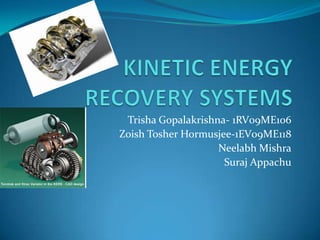
Kinetic energy recovery systems
- 1. Trisha Gopalakrishna- 1RV09ME106 Zoish Tosher Hormusjee-1EV09ME118 Neelabh Mishra Suraj Appachu
- 2. What is a K.E.R.S? KERS is a technology which is in it’s infancy, but once it has developed sufficiently, it could be one of the best things to have happened in the automobile world. KERS stands for Kinetic Energy Recovery System. Basically, it’s working principle involves storing the energy involved with deceleration and using it for acceleration. That is, when a car breaks, it dissipates a lot of kinetic energy as heat. The KERS tries to store this energy and converts this into power, that can be used to boost acceleration.
- 3. Through the years KERS has been in the research and development stage since the 90s and still is. It was fist introduced to the general public through the 2009 series of Formula 1 motor sport. Since then it has been banned (2010 season) and re introduced ( 2011 season). DID YOU KNOW? Vodafone McLaren Mercedes became the first team to win an F1 GP using a KERS equipped car when Lewis Hamilton won the Hungarian Grand Prix on July 26, 2009. On August 30, 2009, Kimi Räikkönen won the Belgian Grand Prix with his KERS equipped Ferrari. It was the first time that KERS contributed directly to a race victory, with second placed Giancarlo Fisichella claiming "Actually, I was quicker than Kimi. He only took me because of KERS at the beginning"
- 4. Not many teams have taken up KERS. One of the main reasons is because it adds an extra 25 kgs of weight. While not adding to the total weight of the car, it does incur a penalty particularly seen in the qualifying rounds, as it raises the car’s centre of gravity and reduces the amount of ballast that is available to balance the car so that it is more predictable when turning. KERS was introduced by the Fédération Intérnationale de l’Automobile (FIA) with a view to increase overtaking during races, as the boost button provides extra power. In effect, the KERS has also been used to act as a defensive tool to block a faster car, inhibiting overtaking. Almost every team has voted against using KERS in 2010 and the system will not be allowed in Formula One.
- 5. At the present state of research, there are two ways in which KERS can be implemented – energy can be stored as mechanical energy(as in a flywheel) or as electrical energy(as in a battery or super capacitor). The electrical system uses a motor-generator incorporated in the car’s transmission which converts mechanical energy into electrical energy and vice versa. Once the energy has been harnessed, it is stored in a battery and released when required. The mechanical system captures braking energy and uses it to turn a small flywheel which can spin at up to 80,000 rpm. When extra power is required, the flywheel is connected to the car’s rear wheels,
- 7. PRINCIPLE Recovery of large proportion of wasted kinetic energy from the brakes and storage in batteries. Energy in batteries then used to boost existing engine power to give the driver extra horsepower.
- 9. WORKING Standard KERS operated on a ‘charge cycle’ and a ‘boost cycle’. As the car slows for a corner, an electric motor (or alternator) captures the waste kinetic energy from the rear brakes. This collected kinetic energy is then passed to a Central Processing Unit (CPU) and onto the batteries. The batteries sit underneath the driver’s seat and are positioned centrally to minimise the impact on the balance of the car. When the driver presses the ‘boost button’ on the steering wheel, the batteries transfer the stored energy back to the engine for a maximum of 6.67s per lap. This extra energy contributes around 80hp and can shave up to four tenths off a lap time.
- 10. Mechanical KERS
